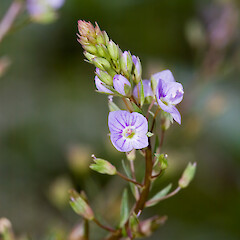Veronica americana
Common name
American brooklime, American speedwell
Family
Plantaginaceae
Flora category
Vascular – Exotic
Structural class
Herbs - Dicotyledons other than Composites
Conservation status
Not applicable
Brief description
Sprawling perennial herb up to 30 cm tall with opposite shortly stalked leaves and small (c. 1 cm across) blue flowers.
Distribution
Common in the Waikato, Bay of Plenty, and scattered in the southern North Island, Canterbury and Westland.
Habitat
Margins of flowing water bodies, seeps
Wetland plant indicator status rating
Information derived from the revised national wetland plant list prepared to assist councils in delineating and monitoring wetlands (Clarkson et al., 2021 Manaaki Whenua – Landcare Research Contract Report LC3975 for Hawke’s Bay Regional Council). The national plant list categorises plants by the extent to which they are found in wetlands and not ‘drylands’. The indicator status ratings are OBL (obligate wetland), FACW (facultative wetland), FAC (facultative), FACU (facultative upland), and UPL (obligate upland). If you have suggestions for the Wetland Indicator Status Rating, please contact: [Enable JavaScript to view protected content]
OBL: Obligate Wetland
Almost always is a hydrophyte, rarely in uplands (non-wetlands).
Detailed description
Perennial growing from shallow creeping rhizomes, hairless throughout, with erect, ascending or trailing, simple stems 10-60 cm long. Leaves: opposite, glossy, all shortly stalked, evidently with small saw-teeth to almost entire, lanceolate to lance-ovate or narrowly almost triangular, or the lower more elliptic, mostly 1.5-8 cm long, 0.6-3 cm wide, generally 2-4 times as long as wide, or the lower a little wider. Flowers: many in long-stalked, open, elongated clusters, mostly 10- to 25-flowered, from upper leaf axils. Corolla 5-10 mm wide, blue or pale violet to almost white, with 4 broad lobes and 2 spreading stamens. Style 2.5-3.5 mm long. Flower stalks in fruit spreading, 5-14 mm long. Fruits: capsule, swollen, 3 mm high and about as wide or slightly wider, scarcely notched. Seeds numerous, 0.5 mm long or less.
Similar taxa
V. americana is distingushed from the other spp of Veronica by its strongly toother leaves that occur on stalks.
Flowering
Summer to autumn
Flower colours
Blue, Violet/Purple
Fruiting
Autumn
Life cycle
Perennial
Year naturalised
1940
Origin
North America
Reason for introduction
Probably a soil seed contaminant or contaminant of ornamental pond plants
Control techniques
Not controlled in New Zealand.
Etymology
veronica: Named after Saint Veronica, who gave Jesus her veil to wipe his brow as he carried the cross through Jerusalem, perhaps because the common name of this plant is ‘speedwell’. The name Veronica is often believed to derive from the Latin vera ‘truth’ and iconica ‘image’, but it is actually derived from the Macedonian name Berenice which means ‘bearer of victory’.
americana: Of South America
Attribution
Factsheet prepared by Paul Champion and Deborah Hofstra (NIWA).






